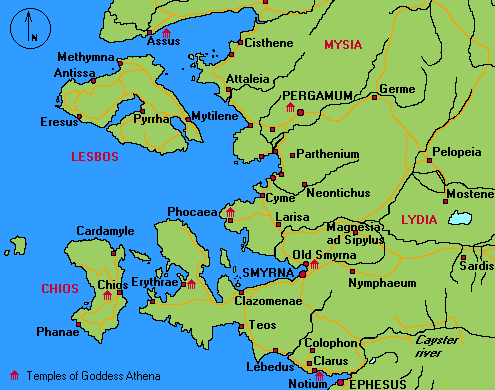A district of Asia Minor, in the middle of the western side of the peninsula, between Mysia on the north and Caria on the south, and between Phrygia on the east and the Aegean Sea on the west. Its boundaries varied so much at different times that they cannot be described with any approach to exactness till we come to the time of the Roman rule over western Asia. At that time the northern boundary, towards Mysia, was the range of mountains which form the northern margin of the valley of the Hermus, called Sardené, a southwestern branch of the Phrygian Olympus; the eastern boundary, towards Phrygia, was an imaginary line; and the southern boundary, towards Caria, was the river Maeander, or, according to some authorities, the range of mountains which, under the name of Messogis (Kastane Dagh), forms the northern margin of the valley of the Maeander, and is a northwestern prolongation of the Taurus. From the eastern part of this range, in the southeast corner of Lydia, another branches off to the northwest, and runs to the west far out into the Aegean Sea, where it forms the peninsula opposite to the island of Chios. This chain, which is called Tmolus (Kisilja Musa Dagh), divides Lydia into two unequal valleys, of which the southern and smaller is watered by the river Ca˙ster, and the northern forms the great plain of the Hermus; these valleys are very beautiful and fertile, and that of the Hermus especially is one of the most delicious regions of the earth. The eastern part of Lydia and the adjacent portion of Phrygia, about the upper course of the Hermus and its tributaries, is an elevated plain, showing traces of volcanic action, and hence called Catacecaumené (katakekaumenê). In early times the country had another name, Maeonia (Mêioniê, Maionia), [p. 984] by which alone it is known to Homer, who is himself sometimes spoken of as Maeonides; and this name was afterwards applied specifically to the eastern and southern part of Lydia; and then, in contradistinction to it, the name Lydia was used for the northwestern part.
In the mythical legends the common name of the people and country, Lydi and Lydia, is derived from Lydus, the son of Atys, the first king. The Lydians appear to have been a race closely connected with the Carians and the Mysians, with whom they observed a common worship in the temple of Zeus Carius at Mylasa; they also practised the worship of Cybelé, and other Phrygian customs. Amid the uncertainties of the early legends, it is clear that Lydia was a very early seat of Asiatic civilization, and that it exerted a very important influence on the Greeks. The Lydian monarchy, which was founded at Sardis before the time of authentic history, grew up into an Empire, under which the many different tribes of Asia Minor west of the river Halys were for the first time united. Tradition mentioned three dynasties of kings: the Atyadae, which ended (according to the backward computations of chronologers) about B.C. 1221; the Heraclidae, which reigned 505 years, down to 716; and the Mermnadae, 160 years, down to 556. Only the last dynasty can be safely regarded as historical, and the fabulous element has a large place in the details of their history; their names and computed dates were:
(1) Gyges, B.C. 716-678;
(2) Ardys, 678-629;
(3) Sadyattes, 629-617;
(4) Alyattes, 617-560;
(5) Croesus, 560 (or earlier)-546, under whose names an account is given of the rise of the Lydian Empire in Asia Minor and of its overthrow by the Persians under Cyrus.Under these kings the Lydians appear to have been a highly civilized, industrious, and wealthy people, practising agriculture, commerce, and manufactures, and acquainted with various arts; and exercising, through their intercourse with the Greeks of Ionia, an important influence on the progress of Greek civilization. Among the inventions or improvements which the Greeks are said to have derived from them were the weaving and dyeing of fine fabrics; various processes of metallurgy; the use of gold and silver money, which the Lydians are said first to have coined, the former from the gold found on Tmolus and from the golden sands of the Pactolus (now Sarabat); and various metrical and musical improvements, especially the scale or mode of music called the Lydian, and the form of the lyre called the magadis. (See Lyra; Musica.) The Lydians had, also, public games similar to those of the Greeks. Their high civilization, however, was combined with a lax morality; and after the Persian conquest, when they were forbidden by Cyrus to carry arms, they sank gradually into a by-word for effeminate luxuriousness, and their very name and language had almost entirely disappeared by the commencement of our era. Under the Persians, Lydia and Mysia formed the second satrapy. After the Macedonian conquest Lydia belonged first to the kings of Syria, and next (after the defeat of Antiochus the Great by the Romans) to those of Pergamus, and so passed, by the bequest of Attalus III., to the Romans, under whom it formed part of the province of Asia.
The chief cities of Lydia were Sardes (Sart), Magnesia (Manissa), Thyatira (Ak Hissar), Philadelphia (Ala Shehir), and Hypaipa (Birghé). See Stark, Nach dem griechischen Orient (1874); Prof. Sayce, in the Journal for Hellenic Studies (1880); and Gregorovius, Kleine Schriften zur Geschichte und Cultur, vol. i. (1887). For the art of Lydia, see Perrot and Chipiez, Hist. of Art in Phrygia, Lydia, etc., pp. 232-301 (Lond. and N. Y. 1892). For Lydian numismatics, see Head, The Coinage of Lydia and Persia (London, 1874-77). For the supposed connection of the Lydians with the Etruscans, who were sometimes called Lydi (e. g. Verg. Aen.ii. 781). (Harpers Dictionary of Classical Antiquities, 1898)
